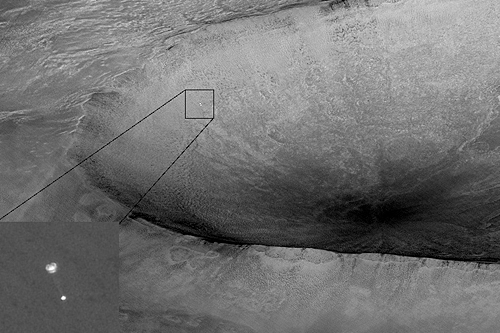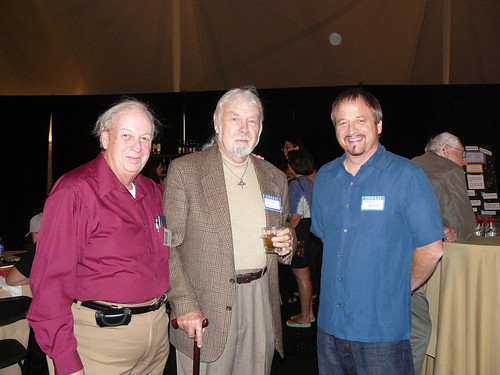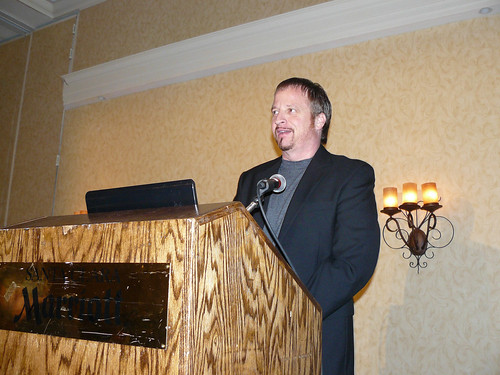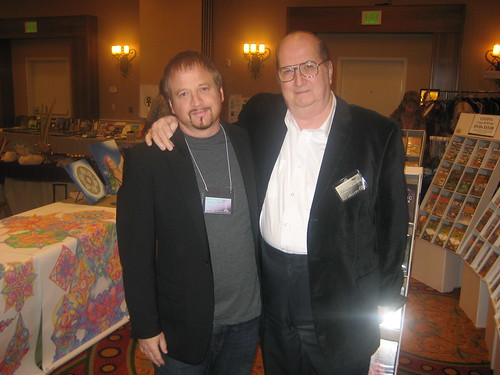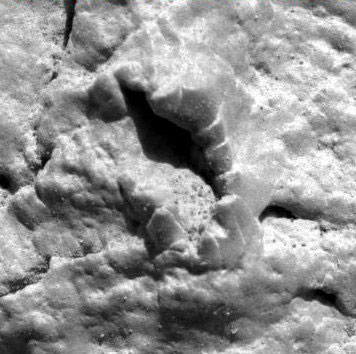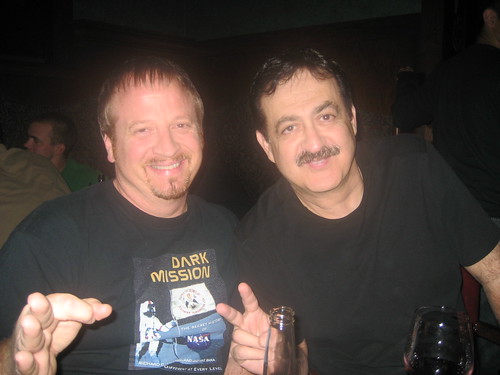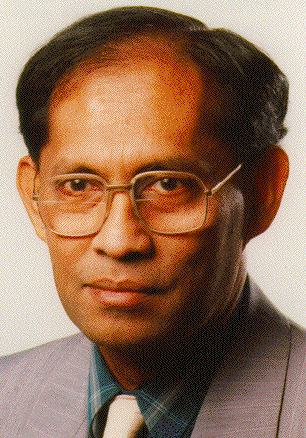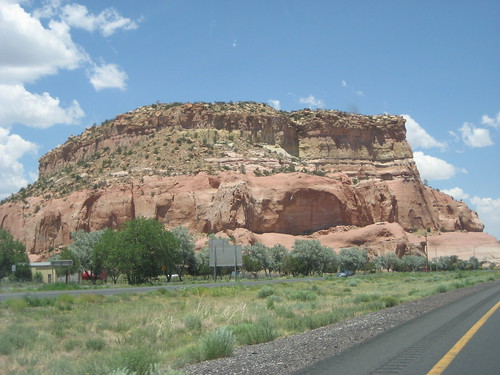As you may know, an image of the first confirmed extrasolar planet ever photographed was released on Monday of this week. Unlike
previously photographed Exoplanets, this one appears to have a mass less than the 13 Jupiter masses which is the accepted limit for planetary designation. At only 8 Jupiter masses, the new planet is well under the mass that would place it in the
Brown Dwarf category. Although the newly discovered planet is the right size to be a Brown Dwarf, this low mass implies that it is not.
University of Toronto researchers managed to
snap a near infrared image of the gas giant planet orbiting more than 330 AU's from its parent star, 1RXS J160929.1-210524. Both objects are about 500 light years away.
This incredible orbital distance, which calculates to an orbit of some 6,000 years, is a direct contradiction to the accretion theory of planetary formation. The star itself is thought to be only about 5 million years old, the blink of eye in astrophysical terms, and the mere presence of the gas giant world creates all sorts of problems for the conventional model.
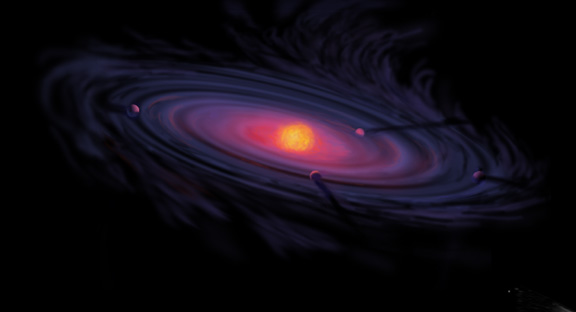
According to current theories, planets form from the remnants of
stellar nebula's in so-called
proto-planatary disks. However, according to current understanding of this theory, large gaseous planets (or planets of any kind) cannot form at this distance from stars because there is unlikely to be sufficient rocky material to form a mass large enough to collapse into a planet. Instead, scientists are now scrambling to explain how such a young, hot companion could have found itself so far from its parent star, and apparently in a stable orbit. The current theory du-jour is that it was somehow magically flung away from the star by an encounter with another star or due to collisions within the accretion disk. Unfortunately, there is no observational evidence or computer modeling to support this assertion. A better explanation is that the planetary accretion model is simply wrong.
Fortunately for the truly curious, there is a second competing theory of planetary formation that is supported by
all of the existing observational evidence – including the discovery of the gas giant 330 AU from 1RXS J160929.1-210524. Some scientists, like
Dr. Tom van Flandern, have long argued for the
solar fission model of planetary formation.
Click
here for video
In the fission model, once the rapidly coalescing solar nebula collapses and achieves sufficient density to begin nuclear fusion, it soon begins spinning so fast that the centrifugal forces become stronger than the gravitational field of the star, and solar material is flung out from the equatorial region of the young star. This material then spirals outward in twin pairs, forming first gas giant planets and then later terrestrial or rocky planets as the star’s angular momentum dissipates. This theory, unlike the solar accretion theory, neatly fits most, if not all, planetary observational data.
The solar fission theory would explain why all the planets are in the so-called
plane of the ecliptic, why the planets hold 98% of the total solar system
angular momentum but just a fraction (0.002) of the
mass, why all of the planets have
prograde orbits (matching the prograde spin of the sun), why other extrasolar gas giants seem to have
formed so close to their parent stars, and why the planets in our own solar system seem to have formed in relatively similar pairs (Earth and Venus, Mercury and the Moon, Jupiter and Saturn, Uranus and Neptune).
There are naturally objections to the twin pair concept, notably that there is as yet little evidence that Mercury was once a moon of Venus, and that Jupiter is more massive than Saturn (in the twin pairs model it should be the other way around), and that Mars does not fit this model at all. However, in the
Exploded Planet Hypothesis, all of this is easily explained, and not by some fairy-tale, move-the-goalposts band aid, but by actual observational evidence.
Our own
Mars Tidal Model proves, with one simple correlative observation, that Mars has tidal bulges. The mere existence of these tidal bulges where none should exist is
De facto proof that Mars is not a planet at all, but rather a moon of a much larger planet (designated “Planet V” in the EPH) that once existed near the orbit that Mars now occupies. It also implies - if the solar fission model is correct - that there is a missing “twin” of Planet V somewhere out there in the solar system.
OK, so where is it?
The EPH also builds on the idea of the old
Titius-Bode law of planetary spacing. Roughly stated, TB says that each successive planet is about twice as far from the sun as the previous planet. Using the following chart, this all works out pretty well for the most part:
As you can see, until we get to Neptune, the TB Rule works almost perfectly. Only at the far reaches of the Solar system do we begin to see significant deviation. The following chart illustrates the point succinctly:
The only exceptions here are Ceres, which is not a planet but rather a prominent body in the asteroid belt between Mars and Jupiter, and Neptune, which seems pretty far out of the margin we would expect if TB was correct. Neptune is dealt with in van Flandern’s book
Dark Matter, Missing Planets and New Comets, so we won’t get into that here. The main point is that according to the EPH, there are at least two missing planets in our solar system, Planet V, the parent planet of Mars, and Planet K, which once existed in the orbit now occupied by the asteroid belt. They would most likely have been terrestrial pairs, similar to Earth and Venus but with much larger masses and planetary radii.
So the asteroid belt turns out to be where Planet K once roamed, accounting for the multitude of bodies in that rocky ring of planetesimals. The EPH also explains one other enduring mystery of the solar system – why Mars and Mercury have the two most eccentric orbits of all the “planets.”
If, as the EPH postulates, Mars was once a moon of Planet V and Mercury a moon of Venus, then it would stand to reason that they, having been recently ejected some 65 MYA, would have non-circular or “eccentric” orbits. This is in fact exactly what we see. Mercury (
0.206) and Mars (
0.093) have by far the most elliptical orbits of any of the major planetary bodies.
So what does all this have to do with the newly discovered gas giant around 1RXS J160929.1-210524? Well, it seems obvious that we are seeing, in near real time, the birth of a new planet in accordance with the fission model. It has been ejected from its parent star a relatively short time ago, and is already some 330 AU from its birth place. Not only does this tell us that planets can exist that far from a parent star (which greatly increases the likelihood that a Planet X exists in our own solar system), but it also explains how massive gas giants can be found so close to their parent stars, as has been observed in some other cases. It’s obvious that these close-in gassy planets have only been recently excreted from their parent stars.

It should be a fairly easy task to calculate its rate of recession from 1RXS J160929.1-210524 (let’s just call it 1RXS from now on, shall we?) - if it is receding at all - and determine (based on its luminosity) how long it has been traveling away from 1RXS. That will give us a timetable for about how long it should take a star of similar mass and composition to start spitting out planets and give us a fighting chance of training our cameras on another candidate star and perhaps catch it in the act of spewing out its first planet.
And wouldn’t that be a picture?










